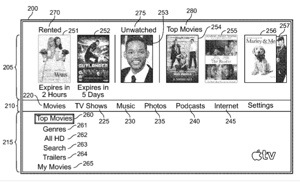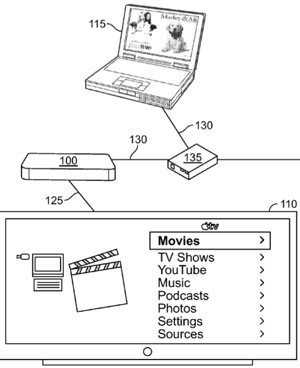Apple patent (number 20110099519) for a menuing structure for media content has appeared at the US Patent & Trademark Office. It involves the Apple TV and its on-screen menus and its interaction with Macs on a local network.
According to the patent, methods, systems, articles of manufacture, and apparatus for causing a computer system such as a media device to perform operations may include receiving input from the user selecting a media type category, identifying media content items within the selected media category that the user has previously selected for presentation, prioritizing the identified media content items based on a predetermined set of rules, and presenting to the user a menu of at least some of the identified media content items in an order based on a result of the prioritization. The inventors are Jeffrey Ma, Elbert D. Chen, Jeffrey Robbin, Calin Pacurariu, William Martin Bachman and James A. Young.
Here's Apple's background and summary of the invention: "Generally speaking, a media device, also known as a digital media receiver or digital media adapter, is a special purpose computer system that can connect to a packet-switched network to retrieve digital media files or streams (such as music, pictures or video) from a personal computer or other media server and play them back on a home theater system or TV. As media devices and online providers of media content have become more prevalent, the choices of media types and selection of particular media items have grown considerably and will continue to do so. Manufacturers of media devices strive to present this vast array of available media choices to a viewer in a meaningful way.
"The disclosed media menuing structure enables the presentation of multiple different types of media (e.g., movies, TV shows, music, photos, podcasts and websites) in a user-friendly and intuitive manner. In general, in one aspect, the subject matter described here can be implemented to include using a computer system to perform a method, an article of manufacture having machine-accessible instructions to cause a machine to perform the method, and/or a device or other apparatus having memory storing instructions and a processor configured to execute the stored instructions to perform the method.
"In an implementation, the method may include receiving input from the user selecting a media type category, identifying media content items within the selected media category that the user has previously selected for presentation, prioritizing the identified media content items based on a predetermined set of rules, and presenting to the user a menu of at least some of the identified media content items in an order based on a result of the prioritization.
"Optionally, the method may include one or more of the following aspects: displaying indicia in the menu indicating to which of a plurality of different groups the presented media content items belong; the groups may vary with the selected media type category; at least one of the groups may correspond to items of media that are not yet completely played back; at least of the groups may correspond to items of media recently acquired; at least of the groups may correspond to items of media with upcoming expiration times; at least of the groups may correspond to items of media that have been recently accessed; at least of the groups may correspond to items of media that are popular according to a predefined metric; at least of the groups may correspond to items of media that the user has not yet acquired; presenting a menu to the user may include displaying at least two separate regions including a media type region in which a plurality of different media type categories are displayed and a shelf region in which individual media content items are displayed; the media content items may be displayed in shelf region change in response to change in choice of media type category; when an insufficient quantity of media content items exists to fill the shelf, a remainder of the shelf may be filled with media content items selected by a third party; designing the set of predetermined rules to result in prioritization of media content items that the user is most likely to want to access; designing the set of predetermined rules to result in media content items that the user is most likely to want to access having a high priority; and/or designing the set of predetermined rules to result in media content items that the user has most recently acquired having a high priority.
"The subject matter described in this document can be implemented to realize one or more of the following potential advantages. For example, a media menuing structure can be implemented that makes intelligent choices about the media content items most likely to be of interest to a user. Those media items, which tend to be the newest and freshest items of media content, are displayed and made available to the user in a prominent location within the menu structure, thereby facilitating ease of access and increasing the likelihood that they will be noticed by the user."
-- Dennis Sellers














